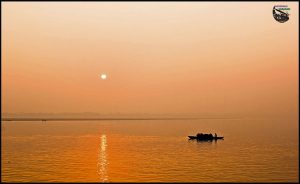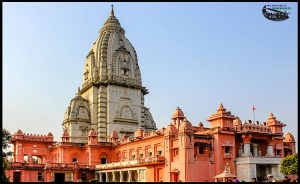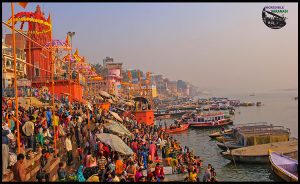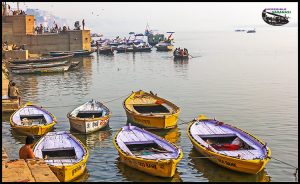India is the land of varied cultures and traditions. The colourful festivals are an integral part of every Indian. The vibe of these festivals are very much visible in Varanasi. It is a common saying that each day is a day of festival in Varanasi. Varanasi, the melting pot of the culture, keeps glowing with the fairs and festivals all-round the year. The major fairs and festivals, that make the soul of Varanasi alive, are following:
Makar Sankranti: This is the first important festival in the beginning of a calendar year. It is an important festival dedicated to The Sun in the lunar-based Hindu calendar. The sun enters from the Southern Hemisphere to the Northern Hemisphere on this day. The festival is also known as the Festival of Movement, since its calculation is base on the movement of the sun. This festival is celebrated every year on 14th January. On this day, the Sun also enters the sphere of Capricorn zodiac known as Makar. The transition from one zodiac to another is known as Sankranati . The name of the festival is derived from this as Makar Sankranti.
It is a good day to start all the important works. Despite of the peak winter season, thousands of people arrive to take bath in the Holy Ganga River in Varanasi. It is a great occasion to feel the many vibrant colours of the Indian Culture in Varanasi. In the other parts of India, the festival is celebrated as the Festival of Harvest.
All the shops sell Lai, Chiwda etc in the market and get decorated as early as one week before the festival. People used to eat Lai , Chiwda, Rabri, Laddu of Til (Sesame) etc after taking bath in the morning. It is also an important day to fly kites in the sky. The sky gets covered with the flying kites during the whole day.
Mahashivaratri : Varanasi is the adobe of Lord Shiva. It is said that Lord Shiva resides in every single particle of Varanasi. Mahashivratri is a festival dedicated to Lord Shiva and it is celebrated in Varanasi with lot of enthusiasm. All Shiva temples in Varamasi are decorated for the occasion. Thousands of visitors thronged to the Shiva Temples from the early morning. They offer milk, the leaves & flowers of Datura (Thorn-Apple or Moonflower) to the Shiva Lingam.
A big procession, known as Shiva Barat (Marriage Party) started from Maha Mrityunjay Temple to Kashi Vishwanath Temple in Dara Nagar. Thousands of people take part in this procession and dressed as Ganas of Lord Shiva dance all the way to the tune of all kinds of instruments.
A small town Kaithi, 29 kms away from Varanasi, is also flocked by the hundreds of pilgrims on the occasion of Maha Shivaratri. A large scale fair is held on the ground of Kaithi.
Drupad Mela : In the same week of Maha Shivaratri, Varanasi also celebrates the biggest festival of Indian Classical Music. Although this festival Drupad Mela is a musical festival, but in reality, it is the soul of the world famous classical music of Varanasi. Drupal is one of the oldest classical music format in India, but it lost its charm with the time. However, in the recent past, people are again taking interest in the classical music due to the promotion of this festival in Varanasi. It is held for five days and entry is free and open to all, with no tickets or passes.
Holi: It is also known as the festival of colours. It is a very important festival and celebrated with a lot o enthusiasm in Varanasi. In fact, the people start pouring colours on each other much before the actual day of the festival. Lot of small shops with lot of coloured items are popped up in the streets during the festival.
On the day of Holi; the children, young, old, male, female everyone join the festival by pouring different colours on each other. The road is also soaked with lot of various colours. The celebration with the colours continues till the mid Noon. After that, all people bath, wear new clothes and visit their friends and family members in the evening. They apply dry colour power on the forehead as tika and seek the blessing of the elders by touching their feet . A lot of sweets dishes are prepared specifically for this day. Gujhhiya is a special sweet dish to enjoy on the occasion of Holi.
Caution During Holi : The festival of Holi may look vulgar and absurd to an outsider. Many bad elements attempts to harass visitors, specially women on this day. Some caution should always keep in the mind:
1 . The celebration of Holi can not be completed without enjoying the Bhaang, a kind of cannabis either in liquid form with milk (known as Thandai) or in solid form with mixing it to a sweet dish or biscuits. It is considered as the most beloved to Lord Shiva. Since it a kind of cannabis, consume it with caution in the appropriate amount.
2. Some antisocial elements use this festival as a guarantee to touch the ladies to apply the colour on their faces and the body parts . As far as possible, holi celebration with unknown people should be avoided and the common sense of safety precautions should be exercise always.
Ganga Dussehra : This festival is celebrated to mark the descend of Holy Ganga on the earth. It is celebrated on the tenth day of the light fortnight of Jyeshtha. Thousands of devotees gather to take a holy bath in the river. A visit to the Ganga Temples at Dashashwamedh and Panchaganga Ghats, floating a clay image of Goddess Ganga riding a crocodile and Ganga Aarti are the other devotional activities of the festival.
Ramadan: This is the most important festival of the Muslims. In the one month long festival of Ramadan, the muslims may not eat or drink anything including water from dawn until sunset. They do not consume food, drink liquids or smoke. Food and drinks are only available after the sunset and until the sunrise. During the daytime, streets in the areas having large muslim population become deserted. After the sunset, the streets again become alive with lot of gathering around the food stalls. It is a good time to enjoy the cultural values of Varanasi on the streets.
Eid al-Fitr: At the end of the month of Ramadan, the muslims celebrate the festival of Eid-Al-Fitr, that is a day of great merriment and thanksgiving. The friends and family visit each other, prepare sweet delicacies, wear new clothes and offer some gifts to each other. They greet each other by saying “ Eid Mubarak”, which means “ Have a blessed Eid”.
Kanwar Yatra in Savan : Kanwar Yatra is a practice of carrying Kanwar ( a bamboo pole carried on the shoulder) by the devotees of Lord Shiva during the holy month of Savan. Two water-pots hang on the each side of Kanwar, in which the devotees (popularly known as Kanwariya) bring the holy water of the mother Ganges to pour over the Shivalinga in the different Shiva Temples.
The entire Varanasi stay coloured in saffron colour during the Kanwar Yatra. The city gets crowded with the hundreds of Kanwariyas warning saffron clothes and carrying kanwar on their shoulder. They shout Bol Bum , Bol Bum throughout the journey.
October:
Durga Puja Festival/Navratri and Vijayadashami/Dussehra: The Durga Puja festival continues for 9 nights, in which the clay statues of Goddess Durga and her 8 other forms are worshipped by the devotees. Huge pandals are erected in the various places of the city with amazing architectural designs. People visit and worship the statues in these pandals. After the nine nights, on the tenth day called Vijayadashami, a great procession is held where the clay statues are ceremoniously walked to the river for a solemn goodbye to Devi Durga.
Dussehra:Dussehra is mainly observed for two reasons in Varanasi:
1. It marks the end of Durga Puja. On this day, a great procession is held where the clay statues are ceremoniously walked to the river for a solemn goodbye to Devi Durga after Navratri.
2. It also marks the end of Ramlila and remembers god Rama’s victory over the demon Ravana. The towering effigies of Ravana, his brother Kumbhakarna and his son Meghanada symbolising the evil is burnt with fireworks marking evil’s destruction. A large crowd of people gather in a big ground in their respective areas/villages to celebrate this event and celebration goes on for the hours.
Ramlila: The Ramlila is a series of plays to describe the life story of Lord Rama as told in Ramcharitmanas composed by Goswami Tulsidas. The plays go on for nearly one month, staging one story of Rama’s life on a given day. The stage performers are normally selected among the local people. The staging of Ram lila happens at many places in the city, but the Ramlila of Ramnagar, a small town on the other bank of Ganga River, opposite to Varanasi; has the legendary status. The permanent and temporary structures to stage the Ramlila in Ramnagar are spread all around the town , hence the entire town turn into a giant open-air stage and audience moves along with performers from one place to another with every episode. As the play progress, and the performers and audience move from one place to another, it gives a feel that every person is a part of the play. The tradition of staging the Ramlila at Ramnagar was started in 1830 by the King of Kashi, and it still has the patronage of the Kashi’s royal family.
Muharram: The annual Muharram festival in Varanasi is celebrated in the memory of Imam Hussain, his horse and his followers who died in the battle of Karbala. In the streets, Shia and Sunni men join the procession of Muharram , slap their chest , sing songs to praise the martyrs and demonstrate their fearlessness with many daring activities like walking on the burning coals. The essence of this festivals lies in piece, brotherhood and community harmony.
Deepawali/Deewali: It is called the festival of lights and celebrated to honour the return of Lord Rama to Ayodhya after completing his 14 years exile in the forest. Lord Rama fought many battles with the demons and the demon king Ravana during his exile and killed all the demons finally. The festival of light also symbolises the victory of good over evil. It is celebrated with oil lamps (diyas), strings of colourful lights and fireworks. People light lamps and draw colourful rangolis outside their houses.
Dev Deepavali: The night of Dev Deepawali is the most spectacular night in Varanasi. It is believed that the Gods descend to earth to bath in the Ganges on this day. All the ghats on the Gangs are decorated with the oil lamps, garlands and lights. Hundreds of thousands of diyas (oil lamps) illuminate the entire river front. A large crowd of men, women, children, young, old, natives and tourists flows along the ghats. Hundreds pf boats loaded with thousands of visitors float between the various ghats of the holy river. A spectacular Ganga Aarti takes place at the Dashashwamedh Ghat. It feels like a kind of religious and cultural experience. A VIP pass is recommended to enjoy the events peacefully.
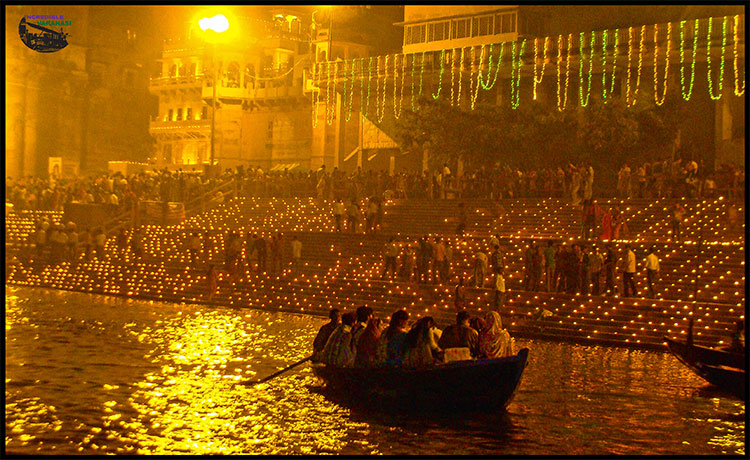
Ganga Mahotsav: The 5-day long festival is organised by the Uttar Pradesh Tourism Department to celebrate Dev Deepawali and also provide a platform to display the cultural legacy of the city. Renowned names from the Indian classical music, classical dance and folk artists take part in the various cultural events like classical musical concerts, dance shows, craft fairs etc, held on the ghats.
Nakkataiya lila: Basically it is a part of the Ramlila plays , in which a popular incident of Ramayana, Nakkataiya (cutting the nose) of Shuparnkha is re-enacted. The Nakkataiya lila of Chetganj is the world famous. After the enactment of the Nakkataiya, a huge and colourful procession representing mythological tales and events, gods and goddesses is also carried out from Lahurabir to Chetganj. The entire stretch from Maldahiya to Chetganj are decorated with the colourful electric lights.
Nag Nathaiya Festival: Apart from the Ramlila, Varanasi is also famous for its Krishna lila, particularly the episode of Kaliya Mardan by Lord Krishna. The staging of Krishna lila was started by Goswami Tulsidas only. The episode is re-enacted on the Tulsi Ghat. In the beginning of lila, Lord Krishna plays the ball with his friends. Suddenly, the ball dip into the river. Krishna dives into the river from a tree, and after having a clash with Kaliya Nag (Cobra with many heads), he defeats Kaliya. He climbs above the many heads of Kaliya and resurfaces in the river with is flute after breaking the egos of Kaliya. A huge celebration takes place on Tulsi Ghat and applauded by large number of devotees. A VIP pass is recommended to enjoy the lila peacefully.
Bharat Milap: It is celebrated to commemorate Lord Rama’s return to Ayodhya after 14 years of exile and his reunion with his brother, Bharat. The Bharat Milan of Nati Imli is the world famous and considered as a Lakkhi Mela, means more than 1 lac people assemble during this festival in Varanasi.
Nag Nathaiya Festival and Nakkataiya lila are the other festivals having the legacy of a Lakkhi Mela, however, now Dev Deepawali and Rathayatra is also considered as Lakkhi Mela.
A person has to stay in Varanasi to understand the festive mood that drive the soul of Varanasi all through the year. The city, where death is also a celebration, there is no reason to mourn for anything else.


